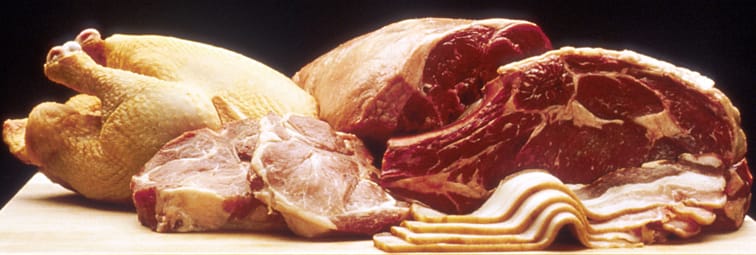meat

Vegetarians don’t eat meat, at least they don’t nowadays. But had there been vegetarians a millennium ago, they would have. For, you see, meat did not always mean the flesh of animals. In Old English, the word mete meant simply food. It comes from the Proto-Germanic root *mati-, relating to eating and food. From the Old English translation of Bede’s Ecclesiastical History:
Þa seo circe gehalgad wæs, & he mæssan gesungen hæfde, ða bæd se gesið hiene, ðæt he eode in his hus & mete þege.
(When the church had been consecrated & he had sung the mass, the man begged him that he go into his house and take meat).
Bede’s original Latin has “ieiunium soluere” (to break the fast).
It wasn’t until the Middle English period, specifically the mid-thirteenth century, that meat started to narrow in meaning to apply only to animal flesh. From a passage about the preparations for Passover from the poem The Story of Genesis and Exodus, lines 3150–53, written c. 1250, with an extant manuscript from before 1325:
Ilc man after his owen fond,
Heued and fet, and in rew mete,
lesen fro ðe bones and eten,
Wið wriðel and vn-lif bread.
(Each man after his own desire, [roast] the meat in bitter herbs, head and feet, pick from the bones and eat, with herbs and unleavened bread.)
Later on the meaning narrowed still further to exclude fish and poultry, and in some regions, it can mean the flesh of specific animals. For example in the southern United States meat is sometimes restricted to pork. And in Hawaii during the first half of the twentieth century meat referred just to beef; the Dictionary of American Regional English records a sign seen in a Honolulu shop window in the 1960s that read, “no meat today, only pork.”
And specific non-animal foods are still referred to as meat. The meat of a nut, for example, is the edible portion inside the shell.
But the Old English sense is not completely lost. Even today, the word is still occasionally used to mean food in general. And meat is often used in a metaphorical sense to mean sustenance, as in the phrase meat and drink. Shakespeare uses the phrase in As You Like It (5.1):
It is meat and drinke to me to see a clowne.
Fleshy meat, as the main dish of a meal, has given rise to a number of metaphorical phrases and sayings. Meat and potatoes, meaning a staple and unsophisticated offering, dates to at least 1846. And the use of meat to mean the main part or gist of a story or matter of importance comes along a couple of decades later.
In Old English the word could also be a verb, meaning to supply or furnish with food. That sense survives today in certain regional dialects, notably in the Appalachian Mountains in the southern United States. While this verb sense, to meat, sounds like and is semantically similar to the Present-Day English verb to mete, the two verbs come from different Germanic roots and are etymologically unrelated.
Sources:
Bede. Ecclesiastical History of the English People. Bertram Colgrave and R.A.B. Mynors, eds. Oxford Medieval Texts. Oxford: Clarendon Press, 1969, 5.4, 462.
Bede. The Old English Version of Bede’s Ecclesiastical History of the English People, Part 1.2. Thomas Miller, ed. Early English Text Society O.S. 96. London: Oxford UP, 1896, 5.4, 394.
Dictionary of American Regional English (DARE), vol. 3, 1996, s.v. meat, n., meat, v.
Etymological Dictionary of Proto-Germanic Online, 2013, s.v. mati-. Brill: Indo-European Etymological Dictionaries Online.
Middle English Dictionary, 2019, s.v. mete, n.(1).
Dictionary of Southern Appalachian English. Michael B. Montgomery and Jennifer K.N. Heinmiller, eds. Chapel Hill: U of North Carolina Press, 2021, s.v. meat, 629–30.
Morris, Richard, ed. The Story of Genesis and Exodus, second edition (1873). Early English Text Society O.S. 7. New York: Greenwood Press, 1996, 90, lines 3150–53.
Oxford English Dictionary, third edition, March 2001, s.v. meat, n.
Shakespeare, William. As You Like It. In Mr. William Shakespeares Comedies, Histories, & Tragedies (First Folio), London: Isaac Jaggard and Edward Blount, 1623, 5.1, 203/2. Folger Shakespeare Library.
Photo credit: US National Institutes of Health, 2009. Wikimedia Commons. Public domain image.